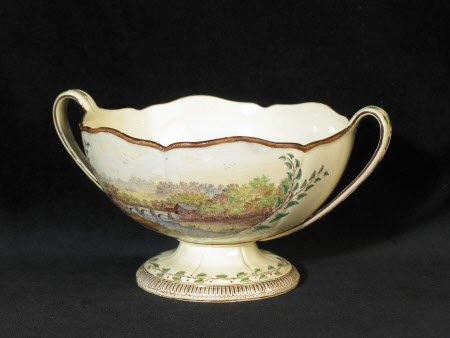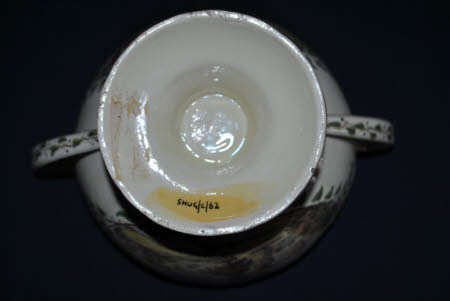Cream bowl
Wedgwood
Category
Ceramics
Date
circa 1774 - circa 1775
Materials
Cream-coloured earthenware (Queen's ware), polychrome enamels
Measurements
90 x 150 mm
Place of origin
Etruria
Order this imageCollection
Shugborough Estate, Staffordshire
NT 1270555.1
Summary
Wedgwood and Bentley round cream bowl for a dessert, creamware (Queen’s ware), of lobed shape with two handles on a spreading foot, the cover with spherical finial, painted in colours with named views of Shugborough, Richmond Castle, Yorkshire, and Ludlow Castle, Shropshire, wreathed in ivy with gadrooned and line borders in brown. The cream bowl and cover were made in Etruria, Staffordshire, and painted in the factory’s decorating studio in Cheyne Row, Chelsea, London, circa 1774-5.
Full description
Wedgwood and Bentley round cream bowl for a dessert, creamware (Queen’s ware), of lobed shape with two handles on a spreading foot, the cover with spherical finial, painted in colours with named views of Shugborough, Richmond Castle, Yorkshire, and Ludlow Castle, Shropshire, wreathed in ivy with gadrooned and line borders in brown. The cream bowl and cover were made in Etruria, Staffordshire, and painted in the factory’s decorating studio in Cheyne Row, Chelsea, London, circa 1774-5. The two views on the cream bowl include: ‘in Shugborough Park’, after a preparatory drawing for a painting still at Shugborough, depicting the Triumphal Arch and the Chinese Pagoda by Nicholas Thomas Dall (fl.1748–77), ca. 1768-75; and ‘near Richmond Castle, Yorkshire’, a view of the triple-arched bridge after an untraced drawing, also possibly by Dall. The cream bowl and its separate cover have historically sat on two different Chinese hardwood stands, one circa 18th Century (see National Trust Inventory Number 1271547) and the other circa 20th Century (see National Trust Inventory Number 1271548), although neither stand is thought to be a component part of the bowl.
Provenance
The first mention of the Shugborough cream bowl and cover is in an undated valuation dating to the start of WWII, described as ‘Empress Catherine of Russia dinner service piece trial, Wedgwood sauceboat and stand, £50’. The long-forgotten Russian service was only re-discovered and popularized in a London exhibition in 1909, which brought similar examples on to the art market resulting in several sales of comparable material. It may have been acquired by Thomas Anson, 3rd Earl of Litchfield (1856-1918), who was keenly interested in family history, and corresponded with many authorities, including Francis "Frank" Hamilton Wedgwood (1863-1930), a descendent and partner in the firm, who assisted with the exhibition.
Marks and inscriptions
Base of tureen: Historic National Trust Inventory Number: Shug/C/062
Makers and roles
Wedgwood, maker

